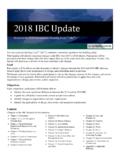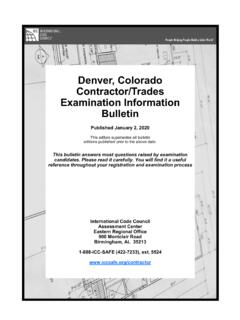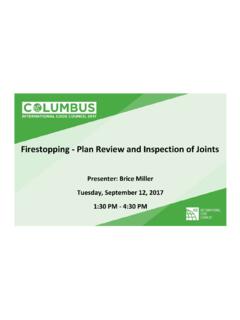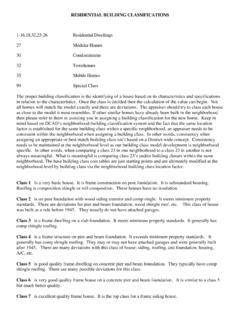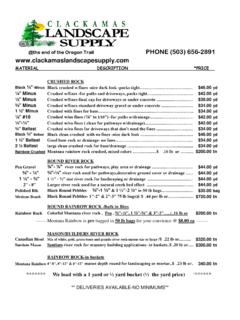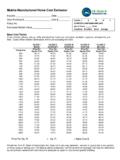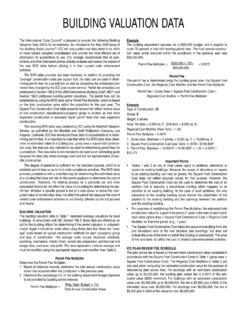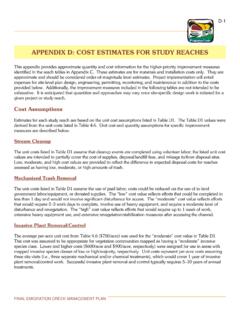Transcription of Building Valuation Data – February 2015 - iccsafe.org
1 Building Valuation data February 2015 The International Code Council is pleased to provide the following Building Valuation data (BVD) for its members. The BVD will be updated at six-month intervals, with the next update in August 2015 . ICC strongly recommends that all jurisdictions and other interested parties actively evaluate and assess the impact of this BVD table before utilizing it in their current code enforcement related activities. The BVD table provides the average construction costs per square foot, which can be used in determining permit fees for a jurisdiction. Permit fee schedules are addressed in Section of the 2012 International Building Code (IBC) whereas Section addresses Building permit valuations.
2 The permit fees can be established by using the BVD table and a Permit Fee Multiplier, which is based on the total construction value within the jurisdiction for the past year. The Square Foot Construction Cost table presents factors that reflect relative value of one construction classification/occupancy group to another so that more expensive construction is assessed greater permit fees than less expensive construction. ICC has developed this data to aid jurisdictions in determining permit fees. It is important to note that while this BVD table does determine an estimated value of a Building ( , Gross Area x Square Foot Construction Cost), this data is only intended to assist jurisdictions in determining their permit fees.
3 This data table is not intended to be used as an estimating guide because the data only reflects average costs and is not representative of specific construction. This degree of precision is sufficient for the intended purpose, which is to help establish permit fees so as to fund code compliance activities. This BVD table provides jurisdictions with a simplified way to determine the estimated value of a Building that does not rely on the permit applicant to determine the cost of construction. Therefore, the bidding process for a particular job and other associated factors do not affect the value of a Building for determining the permit fee.
4 Whether a specific project is bid at a cost above or below the computed value of construction does not affect the permit fee because the cost of related code enforcement activities is not directly affected by the bid process and results. Building Valuation The following Building Valuation data represents average valuations for most buildings. In conjunction with IBC Section , this data is offered as an aid for the Building official to determine if the permit Valuation is underestimated. Again it should be noted that, when using this data , these are average costs based on typical construction methods for each occupancy group and type of construction.
5 The average costs include foundation work, structural and nonstructural Building components, electrical, plumbing, mechanical and interior finish material. The data is a national average and does not take into account any regional cost differences. As such, the use of Regional Cost Modifiers is subject to the authority having jurisdiction. Permit Fee Multiplier Determine the Permit Fee Multiplier: 1. Based on historical records, determine the total annual construction value which has occurred within the jurisdiction for the past year. 2. Determine the percentage (%) of the Building department budget expected to be provided by Building permit revenue.
6 3. Example The Building department operates on a $300,000 budget, and it expects to cover 75 percent of that from Building permit fees. The total annual construction value which occurred within the jurisdiction in the previous year is $30,000,000. Permit Fee The permit fee is determined using the Building gross area, the Square Foot Construction Cost and the Permit Fee Multiplier. Permit Fee = Gross Area x Square Foot Construction Cost X Permit Fee Multiplier Example Type of Construction: IIB Area: 1st story = 8,000 sq. ft. 2nd story = 8,000 sq. ft. Height: 2 stories Permit Fee Multiplier = Use Group: B 1. Gross area: Business = 2 stories x 8,000 sq. ft. = 16,000 sq.
7 Ft. 2. Square Foot Construction Cost: B/IIB = $ ft. Permit Fee: Business = 16,000 sq. ft. x $ ft x = $19,426 Bldg. Dept. Budget x (%) Total Annual Construction Value Permit Fee Multiplier = $300,000 x 75% $30,000,000 Permit Fee Multiplier = = Important Points The BVD is not intended to apply to alterations or repairs to existing buildings. Because the scope of alterations or repairs to an existing Building varies so greatly, the Square Foot Construction Costs table does not reflect accurate values for that purpose. However, the Square Foot Construction Costs table can be used to determine the cost of an addition that is basically a stand-alone Building which happens to be attached to an existing Building .
8 In the case of such additions, the only alterations to the existing Building would involve the attachment of the addition to the existing Building and the openings between the addition and the existing Building . For purposes of establishing the Permit Fee Multiplier, the estimated total annual construction value for a given time period (1 year) is the sum of each Building s value (Gross Area x Square Foot Construction Cost) for that time period ( , 1 year). The Square Foot Construction Cost does not include the price of the land on which the Building is built. The Square Foot Construction Cost takes into account everything from foundation work to the roof structure and coverings but does not include the price of the land.
9 The cost of the land does not affect the cost of related code enforcement activities and is not included in the Square Foot Construction Cost. Square Foot Construction Costs a, b, c, d Group (2012 International Building Code) IA IB IIA IIB IIIA IIIB IV VA VB A-1 Assembly, theaters, with stage A-1 Assembly, theaters, without stage A-2 Assembly, nightclubs A-2 Assembly, restaurants, bars, banquet halls A-3 Assembly, churches A-3 Assembly, general, community halls, libraries, museums A-4 Assembly, arenas B Business E Educational F-1 Factory and industrial, moderate hazard F-2 Factory and industrial, low hazard H-1 High Hazard.
10 Explosives H234 High Hazard H-5 HPM I-1 Institutional, supervised environment I-2 Institutional, hospitals I-2 Institutional, nursing homes I-3 Institutional, restrained I-4 Institutional, day care facilities M Mercantile R-1 Residential, hotels R-2 Residential, multiple family R-3 Residential, one- and two-family R-4 Residential, care/assisted living facilities S-1 Storage, moderate hazard S-2 Storage, low hazard U Utility, miscellaneous a.
